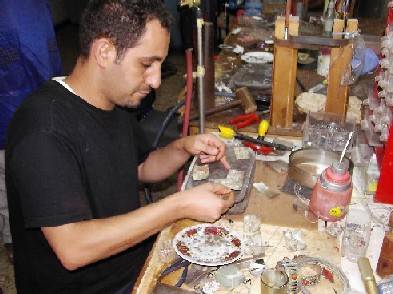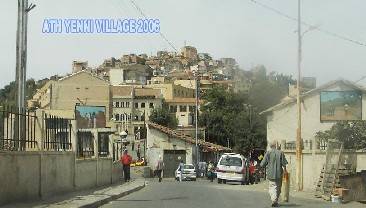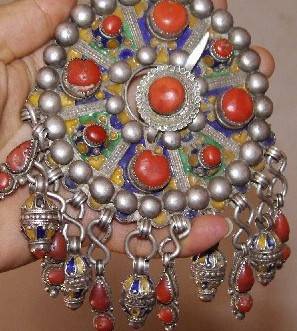 The story of Algerian jewellery dates back to prehistoric times. Since the fine example discovered on Algerian soil, time has revealed more complete works firmly rooted in antiquity and the middle ages.
The story of Algerian jewellery dates back to prehistoric times. Since the fine example discovered on Algerian soil, time has revealed more complete works firmly rooted in antiquity and the middle ages.
Islamic heritage has played a great part, and has been an important determining factor in the story of the development of the Algerian arts and crafts. The advent of Islam in North Africa was to engulf the old civilisations of Rome and Byzantine, and would introduce a new light of inspirational expression, eliminating graphic representations inspired of human and animal forms, advantaging a different set of concepts steeped in Islamic and oriental values, and promoting the use of abstract forms through the use of highly developed geometrical and symmetrical forms in the applied arts. North Africa, particularly Algeria, is a living testimony to the development to these arts and crafts.
`Kabylie` is a region in Northern Algeria. The Kabyle people form one
of the largest divisions of the `Berbers` (indigenous tribes of North Africa) - It is estimated that some 8 million Algerians today are of Kabyle origin. The people of this mountainous region maintain a distinct culture despite invasions by the Vandals, Byzantines, Arabs, Ottomans, and French. The Berbers are known for their fierce resistance to these successive conquerors, and have adopted Islam and Arabic speech, but have retained their distinct vocabulary (Tamazight) and culture.
 Kabyle jewellery uses mainly blue, green, yellow and red (pure Mediterranean coral) colours and is always made with silver.
Kabyle jewellery uses mainly blue, green, yellow and red (pure Mediterranean coral) colours and is always made with silver.
Ath Yenni in the kabylia region that is extremely prolific in jewellery making. The villages in this breathtaking countryside, Taourirt Mimoun, Ait Lahcen, Agouni Ahmed and Taourirt El Hadjadj, have excelled themselves in the art of working with fire and metal. This excellence originates from a time when the people of Ath Yenni perfected the production of false coins. This counterfeit money was faithfully reproduced, that it well-nigh caused the failure of the Turkish economy, then organised under a protectorate system. This tool of revolution, allied to the fabrication of arms, would eventually lead to the mastering of the craft of ironwork, a discipline which was to find its ultimate direction in the fabrication of jewellery.
The popularity and outstanding nature of these productions, is due to an unusual and captivating use of enamel. The blue, green and yellow enamels form an active contrast with which the pieces are set. Enamel is a substance compounded from a fine powder generally made out of sands containing a minimum of potassium and sodium. These are finely ground and vitrified at a high temperature.

for a bright and translucent green, and cobalt oxide for translucent blue whilst copper di-oxide produces a fresh green of deep opacity. The use of lead chromate results is an opaque yellow. Nowadays the artisans content themselves with off-the-shelves enamels, which are ready to use.
The Kabyle technique of enamelling, which involves outlining the parts of the jewellery which are to be coloured, has a character and method of its own. The design is reproduced in silver thread and soldered on to a thin plaque of silver. the blanks between are then carefully decorated with enamel. the piece is left to dry at an ambient temperature and then put in a firing oven. only after having cooled down will the enamelling take on its final brilliant luminosity.
The other fascinating and most attractive piece they also add onto the jewellery is the pure and natural Mediterranean coral, which you can notice in all most of the kabyle jewellery.
The Algerian government can only authorise pure Silver 950 to be exported and as such stamps every single piece of jewellery to prove and certify the authenticity and genuineness of the Silver 950 jewellery.
Proven fact: it has been proven and confirmed by customers that the silver 950 is not infecting sensitive ears (Read feedback from our customers) contrarily to Silver 925 that does cause some ear infections to some people as it contains more metallic alloys. Many people have recovered from their previous infections after wearing the pure Silver950. According to the Australian government, we are the only importers of this pure silver in Australia.
Reference: Some parts of the above text was inspired from "Algerian Handicrafts" By ANEP publishers
Note: To find out more about the Berber and Kabyle people and their handicrafts/Jewellery, just use any search engine, in typing the following keywords: Algeria handictafts, Jewellery, Berbers, Kabyle, Ath Yenni, coral, silver, etc.
